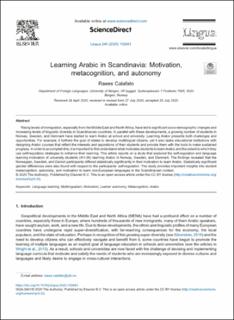Learning Arabic in Scandinavia: Motivation, metacognition, and autonomy
Journal article, Peer reviewed
Published version

Åpne
Permanent lenke
https://hdl.handle.net/11250/2728809Utgivelsesdato
2020Metadata
Vis full innførselSamlinger
Sammendrag
Rising levels of immigration, especially from the Middle East and North Africa, have led to significant socio-demographic changes and increasing levels of linguistic diversity in Scandinavian countries. In parallel with these developments, a growing number of students in Norway, Sweden, and Denmark have started to learn Arabic at school and university. Learning Arabic presents both challenges and opportunities. For example, it furthers the goal of states to develop multilingual citizens, yet it also tasks educational institutions with designing Arabic courses that reflect the interests and aspirations of their students and provide them with the tools to make sustained progress. In order to accomplish this, it is important to first understand what motivates students to learn Arabic and the extent to which they use self-regulatory strategies to enhance their learning. This article reports on a study that explored the self-regulation and language learning motivation of university students (N = 96) learning Arabic in Norway, Sweden, and Denmark. The findings revealed that the Norwegian, Swedish, and Danish participants differed statistically significantly in their motivation to learn Arabic. Statistically significant gender differences were also found with respect to the participants’ self-regulation. The study provides important insights into student metacognition, autonomy, and motivation to learn non-European languages in the Scandinavian context.
